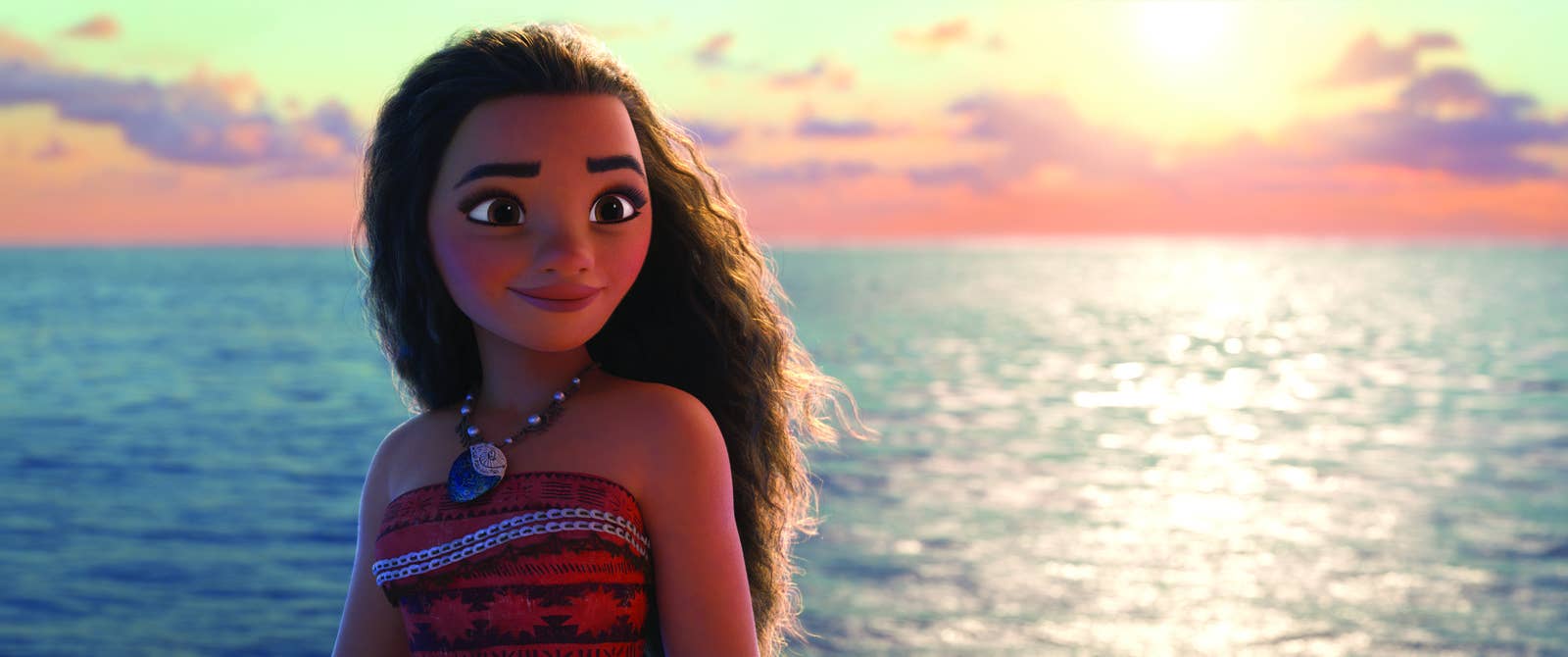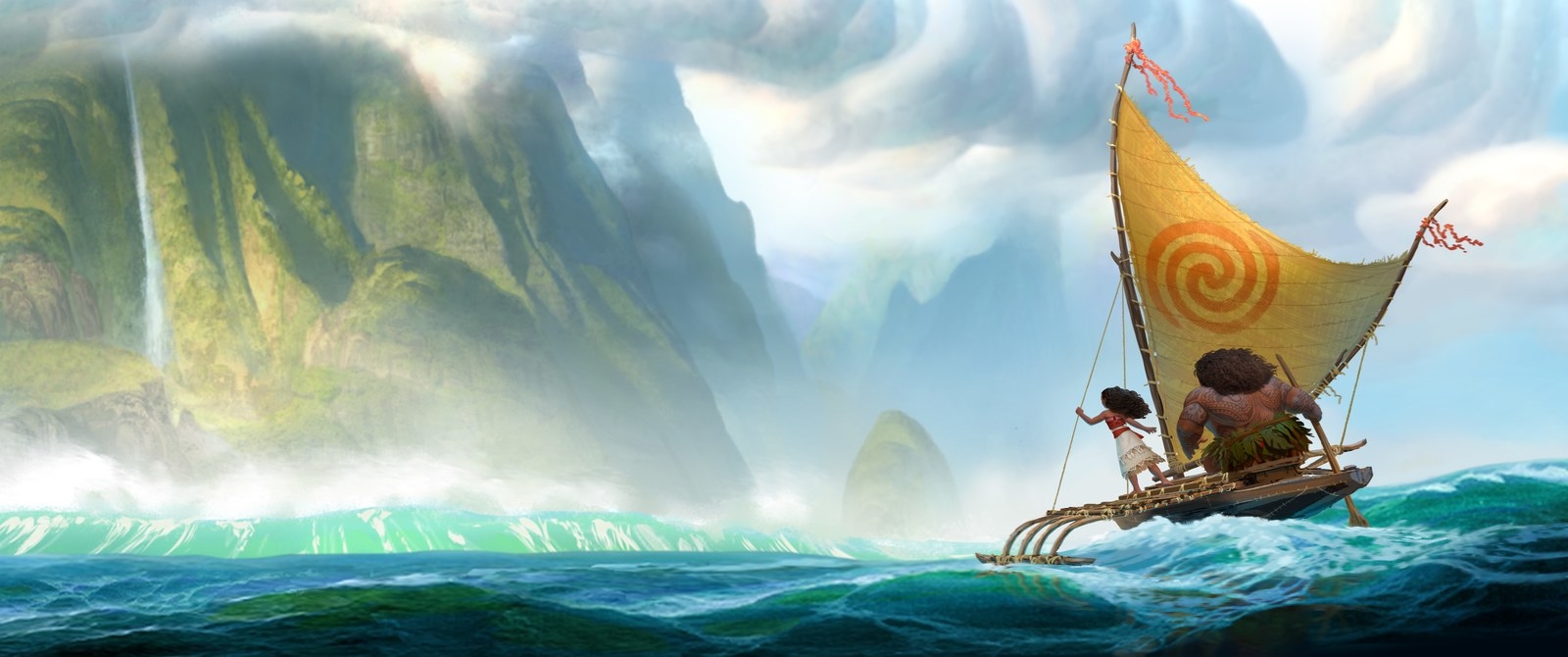
The title character of Moana subverts the established Disney Princess formula in several ways — she’s Disney’s first Polynesian princess, her body is more realistically proportioned than past princess iterations, she isn’t under any pressure to marry despite her royal status, and in the place of a love interest, she has the demigod Maui, her flawed but charismatic mentor. But, most importantly, she's her own hero.
"I think we all feel like we need to evolve these stories, specifically with the female protagonist," Moana screenwriter Jared Bush told BuzzFeed News in a phone interview. "She’s such a badass character. Throughout the movie, she never gives up, no matter what’s thrown at her. That was a conscious effort to evolve what kind of heroes we can put on screen.”
In the movie's last moments, Moana stands before the villainess Te Ka, the fearsome lava monster who's also the assumed guardian of Mother Island Te Fiti. The only thing separating Moana from Te Ka is also the only thing that can save her life: her friend and namesake, the ocean. But Moana isn’t looking to be saved; she’s looking to do the saving herself.

“There’s this way of viewing female heroes that they can’t be all things, and we hope that Moana can be all things,” Bush said. For those who might find her unrealistically capable — a Mary Sue, perhaps — Bush hopes they’ve given her enough facets to avoid that pigeonhole. “There are times when Moana fails, and we wanted to see her fail because that’s what makes her human," he said. "We didn’t want to make her robotic in a way that made an audience member would feel like, ‘Oh, well I could never do that, because she’s perfect every single time!’ We didn’t want her to be perfect, we wanted her to be real.”
Moana spends the entire film believing the ocean chose her to be Maui's sidekick to help him regain his confidence and magical abilities. His success is tantamount to her own, and their journey isn't easy going. "I am Moana of Motunui, you will board my boat," she demands when they first meet. And he does, but not before he steals her boat, throws her off of it, and, ultimately, tries to abandon her.
Now, standing before her monstrous enemy, Moana realizes she wasn't chosen to help Maui gain the skills to defeat Te Ka; Maui was chosen to help Moana save Te Ka with her entirely human abilities.
“Let her come to me,” Moana says calmly, referring to Te Ka, as she holds the goddess Te Fiti's glowing green heart in her hand. If she fails to restore it and end the darkness that’s consuming her homeland, her people will die.
Suddenly, the ocean parts and Te Ka tears down the path, angry and desperate. And then, Moana does what no past Disney Princess has done when paired with a villainess: She identifies with her. As Te Ka charges down the ocean floor, Moana walks forward, framed by walls of water on both sides. She’s composed, unafraid.
She sings to Te Ka: "I have crossed the horizon to find you, I know your name / They have stolen the heart from inside you, but this is not who you are / You know who you are, who you truly are."
Te Ka rears to her full and ominous height, her molten hands posed to strike, but then the meaning of Moana’s words sink into the part of herself she’s forgotten. She crouches, touching her massive ashen forehead to the girl’s and closing her eyes in a Polynesian ritual known as a hongi. When she opens them again, she is Te Fiti, towering green goddess and Mother Island. Her heart is restored, the darkness is ended, Moana’s people have been saved, and it’s a moment that belongs entirely to a Disney Princess and her villainess.
“There’s this nagging question that Moana feels the entire movie, which is, ‘Why was I chosen? Why did the ocean choose me?’” Bush told BuzzFeed News. “And the reason she’s able to discover that Te Ka is Te Fiti is because she and Te Fiti have gone through a similar thing. They’re both in search of their true identity.”
When asked if the finale was an attempt to redeem past Disney narratives that focus primarily on male heroes, Bush didn’t hesitate, saying “100%, yeah." Moana producer Osnat Shurer told BuzzFeed News in a phone interview in mid-November that she views the title character as “an agent of change,” and it rings true throughout the movie. Moana can patch a roof, dance, crack wise with a demigod, march right into that creepy cave and bang that drum; she is Moana of Motunui, and you will board her boat.
The final moment between Moana and Te Fiti is reminiscent of Frozen, when Anna sacrifices her life to save her sister’s by letting her own heart freeze. Though Moana and Te Fiti aren’t related by blood like Anna and Elsa, the sacrifice underscores the large role nature plays in the film. “The idea that what we perceive as the villain of the film is actually ‘nature wronged’ was always an idea that we had, and wanted to build toward,” Shurer said. “It ties back to everything we learned when we spent time in the [Pacific] Islands … that our relationship with nature is the key, honestly, to our lives.”
The story of Te Fiti is one of Disney’s own creation, "but the root is within the culture,” Shurer said. “We love that we were able to assign gender to characters off of the storytelling that we wanted to tell, and not hindered at all by any kind of gender bias."
But just eight months ago, Moana had an entirely different ending. “Originally, Moana and Maui fought Te Ka, and mainly it was Maui who defeated [her],” Bush said. “But what we found was that that ending, first of all, didn't make Moana the star of the third act. We really wanted to get Maui out of the way for that moment.”
Moana's ending went through many, many revisions before the team arrived at the one audiences see on screen. “We wrote quite a few versions,” Shurer said. “In some of them, the island itself was destroyed and had to be pulled back up. We had earlier versions where Moana’s family was held hostage and she had to come and help them. We weren’t always sure we could earn that ending. It took us a while to understand how we could actually get there.”
In the final moments, Moana and Te Fiti share a second hongi before the Disney Princess sets sail for home. It’s quick and quiet, but it’s important; the battle’s over, and the two women share a moment of gratitude and acknowledgment. “There’s a type of hero that I don’t think we’ve seen on screen before,” Bush said. “And I hope that the next generation of young women right now can look at a character like Moana and be inspired by her — frankly, just as much as I want little boys to be inspired by her.”

